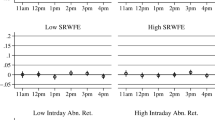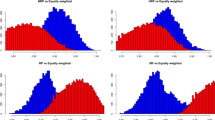Abstract
More information in a market presumably leads to a higher allocative efficiency. In this paper, we study the relationship between the allocative efficiency of a market and the quantity of information about the realisation of the network structure that is available to its participants. We confine our study to thin buyer–seller markets with a few traders who can only trade together if they are linked. We assume that these links are independently formed with the same probability p, assembling a random bipartite graph à la Erdős–Rényi, and that traders behave strategically using linear markup strategies. Under these conditions we derive the equilibrium strategies, for complete and incomplete information about traders’ valuations. We demonstrate that the quantity of information that is available about the network structure has a non-monotonic effect on efficiency. Moreover, the shape of this non-monotonicity flips when we switch from complete to incomplete information about traders’ valuations. Under complete information about valuations it is recommended that traders receive either all the information about the network or nothing, and under incomplete information solely information about the existence of the own trading partners.










Similar content being viewed by others
References
Blume, L., Easley, D., Kleinberg, J., & Tardos, É. (2009). Trading networks with price-setting agents. Games and Economic Behavior, 67, 36–50.
Calvó-Armengol, A. (2001). Bargaining power in communication networks. Mathematical Social Sciences, 41, 69–87.
Cervone, R., Galavotti, S., & LiCalzi, M. (2009). Symmetric equilibria in double auctions with markdown buyers and markup sellers. In C. Hernandez, M. Posada, & A. Lopez-Paredes (Eds.), Artificial Economics (pp. 81–92). Berlin: Springer.
Chatterjee, K., & Dutta, B. (1998). Rubinstein auctions: On competition for bargaining partners. Games and Economic Behavior, 23, 119–145.
Chatterjee, K., & Samuelson, W. (1983). Bargaining under incomplete information. Operation Research, 31(5), 835–851.
Corominas-Bosch, M. (2004). Bargaining in a network of buyers and sellers. Journal of Economic Theory, 115, 35–77.
Easley, D., & Kleinberg, J. (2010). Networks, crowds and markets. New York: Cambridge University Press.
Erdős, P., & Rényi, A. (1960). On the evolution of random graphs. Mathematical Institute of the Hungarian Academy of Sciences, 5, 17–61.
Erdős, P., & Rényi, A. (1961). On the strength of connectedness of a random graph. Acta Mathematica Academiae Scientiarum Hungarica, 12, 261–267.
Gould, M. D., Porter, M. A., Williams, S., McDonald, M., Fenn, D. J., & Howison, S. D. (2013). Modelling limit order books with bilateral trading agreements. Quantitative Finance, 13(11), 1709–1742.
Kranton, E., & Minehart, E. (2001). A theory of buyer–seller networks. The American Economic Review, 91(3), 485–508.
Myerson, R., & Satterthwaite, M. (1983). Efficient mechanisms for bilateral trading. Journal of Economic Theory, 29, 265–281.
Spulber, D. (2006). Firms and networks in two-sided markets. In T. Hendersthott (Ed.), Handbooks in Information Systems (pp. 137–200). Amsterdam: Elsevier.
van de Leur, M. C. W. (2014). Essays on markets over random networks and learning in Continuous Double Auctions. University of Amsterdam Dissertation.
Zhan, W., & Friedman, D. (2007). Markups in double auction markets. Journal of Economic Dynamics and Control, 31, 2984–3005.
Acknowledgements
I thank Marco LiCalzi and participants of the CEF conference in Oslo and the ISDG conference in Amsterdam for their helpful comments and useful suggestions. This study was funded by the European Commission in the framework of the European Doctorate in Economics-Erasmus Mundus (EDE-EM).
Author information
Authors and Affiliations
Corresponding author
Appendices
Appendix 1: Profit Functions Complete Information About Valuations and Costs
The profit functions of buyer \(b_1\) under complete information about valuations and costs are shown below. These are used to calculate the Nash equilibrium markup and markdown strategies. Some best response functions are symmetric and hence we find symmetric markups, and simplifying assumptions about the strategies of others can be made.
Network 1: \(b_1\leftrightarrow {s_1}\)
Buyer \(b_1\) trades if his bid exceeds the ask of seller \(s_1\), \(1-m_1^d\ge {m_1^u}\), which results in a profit of \(\pi \left( m_1^d,m_1^u\right) =1-\frac{1-m_1^d+m_1^u}{2}\). The expected profit is given by \(\mathbb {E}(\varPi _{b_1})=\pi \left( m_1^d,m_1^u\right) \mathbbm {1}_{\left\{ 1-m_1^d\ge {m_1^u}\right\} }\).
Network 2: \( b_1\leftrightarrow {s_1}\, \& \, b_1\leftrightarrow {s_2}\)
Buyer \(b_1\) trades with the seller with the lowest ask \(m^u=m_1^u=m_2^u\), if \(1-m_1^d\ge {}m^u\):
Network 3: \( b_1\leftrightarrow {s_1 }\, \& \, b_2\leftrightarrow {s_1}\)
\(b_1\) only trades when its bid is higher than the bid from \(b_2\), \(1-m_1^d>1-m_2^d\), or with probability one half if they are equal, if \(1-m_1^d\ge {}m_1^u\):
Network 4: \( b_1\leftrightarrow {s_1}\, \& \, b_2\leftrightarrow {s_2}\)
Buyer \(b_1\) trades if \(1-m_1^d\ge {m_1^u}\):
Network 5: \(b_1\leftrightarrow {s_2}\), \( b_2\leftrightarrow {s_1}\, \& \, b_2\leftrightarrow {s_2}\)
Buyer \(b_1\) is only connected to \(s_2\). Unless \(b_2\) and \(s_2\) prefer to trade with each other he trades with \(s_2\), if \(1-m_1^d\ge {}m_2^u\). This happens unless \(m_2^d<1-m_1^d\) and \(m_2^u<m_1^u\):
Network 6: \( b_1\leftrightarrow {s_1}, b_1\leftrightarrow {s_2}\, \& \, b_2\leftrightarrow {s_2}\)
If \(1-m_1^d\ge {}m_1^u\) and \(1-m_1^d\ge {}m_2^u\), buyer \(b_1\) trades with \(s_1\) except when he and \(s_2\) both prefer to trade with each other. The latter happens when \(1-m_1^d>1-m_2^d\) and \(m_2^u<m_1^u\):
Network 7: \(b_1\leftrightarrow {s_1}\), \(b_1\leftrightarrow {s_2}\), \( b_2\leftrightarrow {s_1}\, \& \, b_2\leftrightarrow {s_2}\)
In the symmetric equilibrium both sellers use the strategy \(m^u=m_1^u=m_2^u\). Buyer \(b_1\) can trade as long as his bid exceeds the askprice of the sellers: \(\mathbb {E}(\varPi _{b_1})=\pi (m_1^d,m^u)\mathbbm {1}_{\{1-m_1^d\ge {}m^u\}}\).
Appendix 2: Efficiency Under Incomplete Information About Valuations and Costs
The possible realisations of the network, without permutations, are given below. For each network we show the best response function of buyer \(b_1\) under incomplete information about valuations and costs. Some best response functions are symmetric and hence we find symmetric markups, and simplifying assumptions about the strategies of others can be made. We denote the profit of a buyer with bid \(\beta _i\) trading with a seller with ask \(\alpha _j\) as \(\pi (\beta _i,\alpha _j)\) and similar for sellers. For simplicity we disregard in the notation that the offers are a function of both the strategy and the valuation or cost. The integration limits are set to indicate the region of valuations and costs in which trade occurs.
Network 1: \(b_1\leftrightarrow {s_1}\)
Network 2: \( b_1\leftrightarrow {s_1}\, \& \, b_1\leftrightarrow {s_2}\)
In equilibrium, \(m_1^u=m_2^u=m^u\) and thus \(b_1\) trades with the seller with the lowest cost \(c_\text {min}=\text {min}(c_1,c_2)\) which has pdf \(2-2c_\text {min}\):
Network 3: \( b_1\leftrightarrow {s_1}\, \& \, b_2\leftrightarrow {s_1}\)
\(b_1\) only trades when its bid is higher than the bid from \(b_2\): \(v_1\left( 1-m_1^d\right) >v_2\left( 1-m_2^d\right) \):
Network 4: \( b_1\leftrightarrow {s_1}\, \& \, b_2\leftrightarrow {s_2}\)
The network is split into two separate markets; the best response function of \(b_1\) is the same as in network 1.
Network 5: \(b_1\leftrightarrow {s_2}\), \( b_2\leftrightarrow {s_1}\, \& \, b_2\leftrightarrow {s_2}\)
\(b_1\) is only connected to \(s_2\) and unless \(b_2\) and \(s_2\) prefer to trade with each other he can trade with \(s_2\). Hence with probability \(\mathbb {P}(\text {trade})=1-\left( 1-\text {min}\left\{ 1,\frac{v_1(1-m_1^d)}{1-m_2^d}\right\} \right) \left( 1-\frac{\left( 1-m_2^u\right) c_2+m_2^u-m_1^u}{1-m_1^u}\right) \) buyer \(b_1\) trades. We disregard the possibility that the latter term is negative, since in equilibrium the markup of a trader with two links is higher than the markup of a trader with one link:
Network 6: \( b_1\leftrightarrow {s_1}, b_1\leftrightarrow {s_2} \, \& \, b_2\leftrightarrow {s_2}\)
\(b_1\) trades with \(s_1\) except when he and \(s_2\) both prefer to trade with each other. This happens with probability \(\frac{v_1\left( 1-m_1^d\right) }{1-m_2^d}\left( 1-\frac{\left( 1-m_2^u\right) c_2+m_2^u-m_1^u}{1-m_1^u}\right) =\frac{v_1\left( 1-m_1^d\right) }{1-m_2^d}\cdot \text {max}\left\{ 0,\frac{\left( 1-m_1^u\right) c_1+m_1^u-m_2^u}{1-m_2^u}\right\} \), where we disregard the possibility that the first term is negative:
Network 7: \(b_1\leftrightarrow {s_1}\), \(b_1\leftrightarrow {s_2}\), \( b_2\leftrightarrow {s_1}\, \& \, b_2\leftrightarrow {s_2}\)
In equilibrium, \(m_1^u=m_2^u=m^u\) and thus \(b_1\) trades with the seller with the lowest cost \(c_\text {min}=\text {min}(c_1,c_2)\) which has pdf \(2-2c_\text {min}\), if his bid is higher than the bid of \(b_2\). For a given value of \(\beta _1=v_1(1-m_1^d)\) this happens with probability \(\frac{v_1(1-m_1^d)}{1-m_2^d}\). \(b_1\) trades with the seller with the highest cost \(c_\text {max}=\text {max}(c_1,c_2)\) which has pdf \(2c_\text {max}\), if his bid is lower than the bid of \(b_2\). For a given value of \(\beta _1=v_1(1-m_1^d)\) this happens with probability \(1-\frac{v_1(1-m_1^d)}{1-m_2^d}\):
1.1 Full Information
In the full information setting, traders have knowledge of the entire realisation of the network. Hence Nash equilibrium strategies are calculated per possible network.
Network: \(b_1\leftrightarrow {s_1}\)
Solving the best response function of network 1 gives the Nash equilibrium strategies \(m_1^d=m_1^u\approx 0.227\). This allows us to calculate expected allocative efficiency given the limitations of the network structure, which is the ratio between the expected surplus from trade, divided by the total expected surplus:
Moreover, the expected volume, the ratio between the expected number of trades and the maximal number of trades, equals:
Similarly to the best response function above we calculate the expected profit for a trader that has one link:
Network: \( b_1\leftrightarrow {s_1} \, \& \, b_1\leftrightarrow {s_2}\)
Solving the best response functions of network 2 and a symmetric version of 3 gives the Nash equilibrium strategies \( m^u=m_1^u=m_2^u\approx 0.110\, \& \, m_1^d\approx 0.341\):
Network: \( b_1\leftrightarrow {s_1} \, \& \, b_2\leftrightarrow {s_2}\)
This network is similar to the first network, except with a double expected volume.
Network: \(b_1\leftrightarrow {s_2}\), \( b_2\leftrightarrow {s_1}\, \& \, b_2\leftrightarrow {s_2}\)
Solving the best response functions of network 5 and a symmetric version of 6 gives the Nash equilibrium strategies \( m_1^u=m_1^d\approx 0.169 \, \& \, m_2^u=m_2^d\approx 0.246\):
Network: \(b_1\leftrightarrow {s_1}\), \(b_1\leftrightarrow {s_2}\), \( b_2\leftrightarrow {s_1} \, \& \, b_2\leftrightarrow {s_2}\)
Solving the best response function of network 7 gives the Nash equilibrium strategies
Combining the 4 possibilities of having only one link in the network, the 4 possibilities of having one trader that has two links, the 2 possibilities of having two linked pairs, the 4 possibilities of having 3 links in total, with the possibility of having a fully connected network, gives a function of the expected efficiency in terms of the probability of a link. We show the expected efficiency reduction due to strategic behaviour and the total expected efficiency. The latter is the ratio of efficiency reductions due to strategic behaviour and the limitations of the network:
The expected volume as a function of p is given by
The expected strategy as a function of the probability of a link equals
Conditioning on having one link, respectively two links, we calculate the expected profit:
Moreover, the expected strategy of a trader with one link, respectively two links, is given by
1.2 Partial Information
In this setting, traders know only the realisation of own links and the probability of the other links. Hence Nash equilibrium strategies for having one link \(m^1\) and for having two links \(m^2\) are found based on the best response functions given below.
If a trader has one link the possible networks are 1, 3, 4 or 5 and hence the best response function is given by
If a trader has two links networks 2, 6 or 7 are possible and which results in the following best response function:
The Nash equilibrium strategies are calculated with double precision from these two best response functions. The second derivatives in these points are smaller than zero; ensuring a maximum.
1.3 No Information
With no information the only knowledge about the network is the probability that a link occurs. Hence the best response function of \(b_1\) is a weighted average over all seven best response functions given above. Because of symmetry we may assume that all other traders use the same strategy, i.e. \(m=m_2^d=m_1^u=m_2^u\):
The Nash equilibrium strategy \(m_1^d\) is solved to be the solution in [0, 1] of
Rights and permissions
About this article
Cite this article
van de Leur, M. Information and Efficiency in Thin Buyer–Seller Markets over Random Networks. Comput Econ 51, 1069–1095 (2018). https://doi.org/10.1007/s10614-017-9658-8
Accepted:
Published:
Issue Date:
DOI: https://doi.org/10.1007/s10614-017-9658-8




